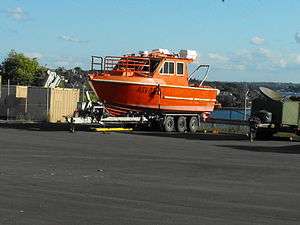ASV Wyatt Earp
The Antarctic Survey Vessel (ASV) Wyatt Earp (ASV 01/DMS 329) is a survey launch operated by the Australian Hydrographic Service since 1993. Based on the Royal Australian Navy's Fantome-class survey launches, Wyatt Earp was built specifically for hydrographic survey duties in Antarctic waters.
 ASV Wyatt Earp in temporary storage at HMAS Waterhen | |
| History | |
|---|---|
| Name: | Wyatt Earp |
| Operator: | Australian Hydrographic Service |
| Builder: | Pro Marine, Seaford, Victoria |
| In service: | 1993 |
| General characteristics | |
| Type: | Survey launch (modified Fantome class) |
| Displacement: | 5.77 t (5.68 long tons; 6.36 short tons) full load |
| Length: | |
| Draught: | 0.53 m (1 ft 9 in) |
| Propulsion: |
|
| Speed: | 22.5 knots (41.7 km/h; 25.9 mph) |
| Range: | 306 nmi (567 km; 352 mi) at 18 kn (33 km/h; 21 mph) |
| Complement: | 4-5 |
| Sensors and processing systems: |
|
Design and construction
Wyatt Earp is a smaller version of the Fantome class survey launches used by the Royal Australian Navy, modified for operations in Antarctic waters.[1] The vessel has a full load displacement of 5.77 tonnes (5.68 long tons; 6.36 short tons), is 8.15 metres (26 ft 9 in) long at the waterline and 9.2 metres (30 ft 2 in) in length overall, and has a draught of 0.53 metres (1 ft 9 in).[1] Propulsion is provided by two Volvo Penta AQAD 41D/SP290 diesels, which provide 400 brake horsepower (300 kW) to the two outdrives.[1] Maximum speed is 22.5 knots (41.7 km/h; 25.9 mph), and Wyatt Earp has a range of 306 nautical miles (567 km; 352 mi) at 18 knots (33 km/h; 21 mph).[1] When built, the boat's sensor suite includes a JRC JMA-2141 navigation radar, an STN Atlas Elektronik Deso 22 echo sounder, and a differential GPS receiver.[1] Wyatt Earp has a complement of four to five.[1][2]
Wyatt Earp was built by Pro Marine at Seaford, Victoria.[1] She entered service in 1993.[1]
Operational history
Wyatt Earp is operated by the Australian Hydrographic Service (AHS).[3] The vessel is not used on a constant basis; her deployment can only occur if a resupply ship chartered by the Australian Antarctic Division is capable of transporting and serving as a base ship to Wyatt Earp and the AHS's Deployable Geospatial Support Team.[3]
The boat was deployed to the Antarctic during 2003 and 2004.[2]
Wyatt Earp was not sent to the Antarctic again until December 2013.[2] During the two-month operation, the survey craft was deployed from Aurora Australis on seven occasions for survey work in the waters around Casey Station.[2]
References
- Wertheim, Eric, ed. (2007). The Naval Institute Guide to Combat Fleets of the World: Their Ships, Aircraft, and Systems (15th ed.). Annapolis, MD: Naval Institute Press. p. 28. ISBN 978-1-59114-955-2. OCLC 140283156.
- Rago, Lauren (23 January 2014). "Mobile Survey Team Home From Antarctic Mission". Navy Daily. Royal Australian Navy. Retrieved 12 May 2015.
- Australian Hydrographic Service (2010). National Report - Australia (PDF). 10th Hydrographic Commission on Antarctica (HCA) Meeting (Report). Hydrographic Commission on Antarctica. Retrieved 8 January 2012.